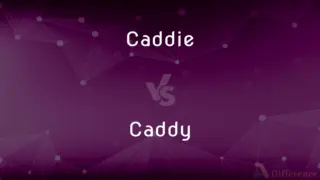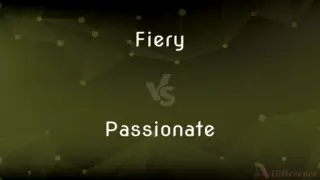Sprite vs. Fairy — What's the Difference?
Edited by Tayyaba Rehman — By Maham Liaqat — Updated on March 12, 2024
Sprites are mythological spirits of nature, often depicted as elusive and smaller than humans, while fairies are supernatural beings with magical powers, commonly portrayed with wings and human-like features.
Difference Between Sprite and Fairy
Table of Contents
ADVERTISEMENT
Key Differences
Sprites are often associated with specific natural elements or locations, such as water, forests, or air. They are usually depicted as being smaller than humans, and their appearance can vary widely, from ethereal and light to more mischievous or even grotesque forms. Fairies, on the other hand, are a more widely recognized category of mythical beings with a rich history in folklore and literature. They are typically imagined as having a human-like form, often with the addition of wings, and are frequently associated with magical abilities.
While sprites are primarily connected to natural elements and phenomena, fairies have a broader domain that often intersects with the human world. Fairies are known to interact with humans, whether for good or ill, and their stories often involve moral lessons or cautionary tales. In contrast, sprites are typically more elusive and less inclined to interact directly with humans. Their role in mythology and folklore often centers around the protection or embodiment of their natural domain, and they may be less likely to engage in the complex social interactions that characterize fairy narratives.
Both sprites and fairies are integral to the folklore of many cultures, and their depictions can vary significantly based on regional traditions and storytelling. While fairies are often celebrated in popular culture and literature, sprites remain a more enigmatic and less defined category of mythical beings, with their characteristics and stories varying more widely from one tradition to another.
Comparison Chart
Origin
Associated with specific natural elements or phenomena
Broadly recognized in folklore with a rich history
Appearance
Varied, often ethereal or connected to their natural domain
Typically human-like with wings, can range from beautiful to mischievous
ADVERTISEMENT
Interaction with Humans
Generally elusive and less inclined to interact with humans
Often interact with humans, can be benevolent or mischievous
Domain
Primarily connected to nature and its protection
Broader domain, often intersecting with the human world
Cultural Representation
Less defined, varies widely across different cultures
Widely recognized and celebrated in literature and popular culture
Compare with Definitions
Sprite
A mythological nature spirit.
The forest sprite protected its domain fiercely.
Fairy
Often depicted with wings and human-like features.
The garden fairy fluttered her delicate wings in the sunlight.
Sprite
Often associated with a specific element.
The water sprite danced atop the river waves.
Fairy
A common figure in folklore and tales.
The fairy tale spoke of a kingdom saved by the courage of a tiny fairy.
Sprite
Less likely to interact with humans.
The mountain sprite observed from afar, never venturing close.
Fairy
Known for interacting with humans.
The fairy offered guidance to the lost travelers.
Sprite
Varied in appearance.
Each sprite in the grove had its unique, ethereal form.
Fairy
Can be benevolent or mischievous.
The mischievous fairy loved playing tricks on unsuspecting villagers.
Sprite
Elusive and less human-like.
The sprite vanished before our eyes, like a whisper of wind.
Fairy
A fairy (also fay, fae, fey, fair folk, or faerie) is a type of mythical being or legendary creature found in the folklore of multiple European cultures (including Celtic, Slavic, German, English, and French folklore), a form of spirit, often described as metaphysical, supernatural, or preternatural. Myths and stories about fairies do not have a single origin, but are rather a collection of folk beliefs from disparate sources.
Sprite
A small or elusive supernatural being; an elf or pixie.
Fairy
A small imaginary being of human form that has magical powers, especially a female one
Fairy gold
She believed she had had fairies at the bottom of her garden
Sprite
An elflike person.
Fairy
A Central and South American hummingbird with a green back and long tail.
Sprite
(Meteorology) A large, dim, red flash that appears above active thunderstorms in conjunction with lightning.
Fairy
An imaginary being in human form, depicted as clever, mischievous, and possessing magical powers.
Sprite
(Archaic) A spirit, specter, or ghost.
Fairy
Offensive Slang Used as a disparaging term for a gay man.
Sprite
(mythology) A spirit; a soul; a shade.
Fairy
The realm of faerie; enchantment, illusion.
Sprite
An apparition; ghost
Fairy
A mythical being with magical powers, known in many sizes and descriptions, although often depicted in modern illustrations only as a small sprite with gauze-like wings, and revered in some modern forms of paganism.
Sprite
(mythology) An elf; a fairy; a goblin.
Fairy
An enchantress, or creature of overpowering charm.
Sprite
(computer graphics) A two-dimensional image or animation that is integrated into a larger scene.
Fairy
A member of two species of hummingbird in the genus Heliothryx.
Sprite
An electrical discharge that occurs high above the cumulonimbus cloud of an active thunderstorm.
Fairy
A legendary Chinese immortal.
Sprite
The green woodpecker, or yaffle (Picus viridis).
Fairy
Like a fairy; fanciful, whimsical, delicate.
Sprite
(entomology) Any of various African damselflies of the genus Pseudagrion (of which, Australian species are named riverdamsels).
Fairy
Enchantment; illusion.
The God of her has made an end,And fro this worlde's fairyHath taken her into company.
Sprite
A spayed female ferret.
Fairy
The country of the fays; land of illusions.
He [Arthur] is a king y-crowned in Fairy.
Sprite
(obsolete) frame of mind, disposition
Fairy
An imaginary supernatural being or spirit, supposed to assume a human form (usually diminutive), either male or female, and to meddle for good or evil in the affairs of mankind; a fay. See Elf, and Demon.
The fourth kind of spirit [is] called the Fairy.
And now about the caldron sing,Like elves and fairies in a ring.
Sprite
A spirit; a soul; a shade; also, an apparition. See Spright.
Gaping graves received the wandering, guilty sprite.
Fairy
An enchantress.
No goblin or swart fairy of the mineHath hurtful power over true virginity.
Sprite
An elf; a fairy; a goblin.
Fairy
Of or pertaining to fairies.
Sprite
The green woodpecker, or yaffle.
Fairy
Given by fairies; as, fairy money.
Sprite
Small, human in form, playful, having magical powers
Fairy
Small, human in form, playful, having magical powers
Fairy
Offensive terms for an openly homosexual man
Common Curiosities
Can sprites have wings like fairies?
While sprites can have various forms, they are less commonly depicted with wings compared to fairies, whose wings are a defining feature.
Can a fairy also be considered a sprite?
In broader terms, fairies can fall under the category of sprites as nature spirits, but not all sprites are fairies due to their more specific characteristics.
What is the primary difference between a sprite and a fairy?
Sprites are nature spirits often tied to a specific element, while fairies are magical beings with more human-like features and broader interactions with humans.
Are all sprites benevolent?
Like fairies, sprites can range in disposition from benevolent to mischievous or indifferent, depending on the folklore.
Can sprites be part of fairy tales?
Yes, sprites can appear in fairy tales, often serving as nature-bound characters or elements of the story's setting.
Do sprites have their own languages or forms of communication?
In folklore, sprites are sometimes attributed with their own languages or mystical forms of communication, often understood only by other nature spirits.
Do fairies always have magical powers?
In most tales and folklore, fairies are endowed with some form of magical abilities, which they may use for various purposes.
Is it common for sprites to interact with humans?
Sprites are typically more elusive and less inclined to interact directly with humans compared to fairies.
Do fairies always appear in human-like form?
While commonly depicted as human-like, fairies can also appear in various forms in different folklore traditions.
Are there specific rituals or offerings associated with fairies or sprites in folklore?
Folklore often includes rituals or offerings to appease or attract fairies or sprites, such as leaving out food or maintaining natural spaces respectfully.
Are there male fairies in folklore?
Yes, folklore includes male fairies, although popular culture often emphasizes female representations.
Are sprites and fairies found in all cultures?
Variants of sprites and fairies appear in many, but not all, cultures, with their attributes varying significantly across different traditions.
Do sprites have a role in modern storytelling?
Sprites continue to inspire modern storytelling, often embodying ecological themes or serving as mystical elements in fantasy works.
How are fairies typically portrayed in children's stories?
In children's stories, fairies are often portrayed as kind, helpful, and magical, embodying whimsy and wonder.
Can fairies and sprites coexist in the same narrative?
Yes, many narratives include both fairies and sprites, each serving different roles within the story's universe.
Share Your Discovery

Previous Comparison
Caddie vs. Caddy
Next Comparison
Fiery vs. PassionateAuthor Spotlight
Written by
Maham LiaqatEdited by
Tayyaba RehmanTayyaba Rehman is a distinguished writer, currently serving as a primary contributor to askdifference.com. As a researcher in semantics and etymology, Tayyaba's passion for the complexity of languages and their distinctions has found a perfect home on the platform. Tayyaba delves into the intricacies of language, distinguishing between commonly confused words and phrases, thereby providing clarity for readers worldwide.














































